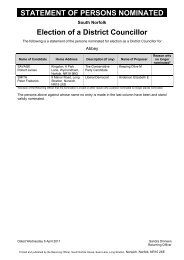October 2012 [PDF, 556 Kb] - South Norfolk Council
October 2012 [PDF, 556 Kb] - South Norfolk Council
October 2012 [PDF, 556 Kb] - South Norfolk Council
Create successful ePaper yourself
Turn your PDF publications into a flip-book with our unique Google optimized e-Paper software.
NORFOLK LOCAL AUTHORITY POLLUTION<br />
PREVENTION & CONTROL NEWSLETTER<br />
Introduction<br />
<strong>October</strong> <strong>2012</strong> issue<br />
Welcome to the third edition of the <strong>Norfolk</strong> LAPPC Newsletter produced<br />
on behalf of and in collaboration with all 7 local authorities across <strong>Norfolk</strong>.<br />
The aim is to give consistent advice across the county aiding with permit<br />
compliance and providing advice to SME. If you have any issues you want<br />
covering then please don’t hesitate to contact your local regulator. Contact<br />
details are listed on the back page.<br />
Contents<br />
• Variations: -<br />
How and When to Apply<br />
• Extension to “operating<br />
below threshold”<br />
• Waste Operations & Permits<br />
• Defra Fees & Charges<br />
• IED Update<br />
• Keep Up-To-Date<br />
• Useful Numbers<br />
Variations: How & When to Apply.<br />
The Environmental Permitting Regulations do not include a variation<br />
notification procedure that is why all permits will have the following condition<br />
as part of the permit:<br />
If the operator proposes to make a change in operation of the installation,<br />
he must, at least 14 days before making the change, notify the regulator in<br />
writing. The notification must contain a description of the proposed change<br />
in operation. It is not necessary to make such a notification if an application<br />
to vary this permit has been made and the application contains a description<br />
of the proposed change.<br />
In accordance with schedules 7 & 8 of the Environmental Permitting<br />
Regulations the Industrial Pollution Prevention & Control Directive<br />
definition of “changes in operation” applies namely to “a change in the<br />
nature or functioning, or an extension, of the installation, which may have<br />
consequences for the environment. A change in operation could entail<br />
either technical alterations or modifications in operational or management<br />
practices or procedures; including changes to raw materials or fuels used<br />
and to the installation throughput.<br />
Many changes at an installation may not have consequences for the<br />
environment however it is always considered good practice to notify the<br />
regulator of any administrative changes such as the name and address<br />
of the operator (where the installation has not changed ownership) and<br />
the regulator can simply amend the permit without going through formal<br />
procedures.<br />
The Industrial Pollution Prevention & Control Directive defines a<br />
“substantive” change as “a change in operation which in the opinion of the<br />
regulator may have significant negative effects on human beings or the<br />
environment.” This definition is also incorporated into the Environmental<br />
Permitting Regulations. For installations covered by the Solvent Emissions<br />
Directive other criteria are also relevant.<br />
Thus in practice it is always better to talk things over with your regulator<br />
before they happen. They will be able to let you know whether a simple/<br />
letter or electronic mail notification will suffice or whether in the case of a<br />
substantive change a formal application is required.<br />
Most variations do not attract a charge - only formal applications for<br />
substantive changes require a fee to be paid.
Extension to the maximum period for operating below threshold.<br />
Has your business reduced in size or is it using fewer raw materials With the exception of reduced fee<br />
processes, all businesses which have a permit to operate based on a threshold level of consumption,<br />
can apply for their permit to be declared “operating below threshold” where the business is operating at<br />
reduced levels.<br />
This means that where a business has fallen below the permit threshold, for example the volume of<br />
solvent used has dropped, but it feels hopeful that business will grow again, to avoid surrender of the<br />
permit only to reapply a few months later, you can apply to have your permit declared operating below<br />
threshold. Subsistence fees are reduced by 60% for these permits. From April <strong>2012</strong> this 3 year period<br />
has been extended to indefinitely. If you feel your business could qualify for this reduction in fees please<br />
contact your local authority for an application form. Your permit will be varied to require you to keep<br />
your local authority updated on your consumption levels and to inform them if you plan on restarting any<br />
redundant equipment.<br />
The above also applies to activities which have been ‘mothballed’. This means they are no longer<br />
operating but the operator wishes to keep the permit rather than surrender and close the installation<br />
permanently.<br />
Waste Operations<br />
Part B – Permitted Activities<br />
Usually you need a permit to undertake waste recovery, treatment, or disposal activities, however<br />
there are situations where this doesn’t apply. These are known as waste exemptions, which are<br />
specific low risk waste operations.<br />
Waste exemptions are normally registered by the Environment Agency. However if the activity is<br />
directly associated to your permitted process, it is not exempt. Your permit will need to be varied to<br />
include conditions regarding your waste operations, this is free of charge.<br />
Waste activities include; use, treatment, disposal and storage. The following are some which are likely<br />
to be directly associated with a permitted process:<br />
U5<br />
U8<br />
T3<br />
T5<br />
T6<br />
T7<br />
T9<br />
Use of waste-derived biodiesel as a fuel<br />
Use of Waste<br />
Use of waste for a specific purpose (especially use of waste paint as paint)<br />
Treatment of Waste<br />
Treatment of waste metals and metal alloys by heating for the purposes of removing grease, etc.<br />
Screening and blending waste (e.g. waste gravel, crushed rocks, shellfish shells, waste bark and wood,<br />
concrete, bricks, tiles and ceramics).<br />
Treatment of waste wood and waste plant matter by chipping, shredding, cutting or pulverising.<br />
Treatment of waste bricks, tiles and concrete by crushing, grinding or reducing in size.<br />
Recovery of scrap metal<br />
Storage of Waste<br />
Some storage activities don’t require exemptions or variations to permits, e.g. the temporary storage waste at<br />
the place of production, pending its collection.<br />
S1<br />
S2<br />
Storage of waste in secure containers (specific waste at a different place to where the waste was<br />
produced, before the waste is transported to another site for recovery e.g. waste oil, paper, cardboard, etc.)<br />
Storage of waste in a secure place e.g. Storing construction and demolition waste, capable of being<br />
reused without treatment, at an intermediate site before it is moved to another place for reuse.<br />
A full list of exempt activities can be found at www.environment-agency.gov.uk/exemptions.<br />
If any of the listed exempt waste activities are directly linked to your permitted process, please contact<br />
your Local Authority for further information and guidance. Any T3 or T7 activities should be registered<br />
with your Local Authority even if they are not directly associated.<br />
Any other activities which aren’t directly associated to your permitted process, should be registered<br />
with the Environment Agency on 03708 506 506 or visit www.environment-agency.gov.uk for further<br />
information.
New LAPPC Fees & Charges for <strong>2012</strong>/13 Part B<br />
Application Fees Price Annual Subsistence Charges Price<br />
Standard process £1,579 Standard process Low Risk £739 (+99*)<br />
Additional fee operating without Permit £1,137 Standard process Medium Risk £1,111 (£149*)<br />
Reduced fee activities (apart from VR) £148 Standard process High Risk £1,672 (+198)<br />
PVR I & II combined £246 For Combined Permit & Waste add * in brackets<br />
Vehicles Refinishers (VRs) £346 Reduced fee activities - (Low/Med/High) £76 / £151 / £227<br />
Reduced Fee: additional fee operating PVR I & II Combined £108 / £216 / £326<br />
without permit £68 Vehicle Refinishers - (Low/Med/High) £218 / £349 / £524<br />
Mobile screening plant Mobile screening plant (Low/Med/High) £618 /£989 / £1485<br />
1st & 2 nd plant £1,579 3 rd to 7 th plant £368 / £590 / £884<br />
3 rd to 7 th plant £943 8 th and subsequent (Low/Med/High) £189 /£302 / £453<br />
8 th and subsequent £477 Where Permit is subject to E-PRTR add £99<br />
Combined Permit & Waste add £297 Add £36 for annual subsistence charges paid quarterly<br />
Transfer<br />
Charge for late payment of fees £50<br />
Substantial Change<br />
Transfer £162 Standard process £1005<br />
Partial transfer £476 Standard process where substantial change results in a new activity £1579<br />
New operator at a reduced fee activity £75 Reduced fee activities £98<br />
Reduced fee activities transfer £0<br />
Reduced fee activity partial transfer £45<br />
Temporary transfer for Mobiles<br />
Surrender<br />
First transfer £51 Surrender ALL part B activities £0<br />
Following enforcement or warning £51<br />
Industrial Emissions Directive 2010/75/EU<br />
The Industrial Emissions Directive (IED) is a recast of 7 existing pieces of legislation, these being directives<br />
on integrated pollution prevention control, solvent emissions, waste incineration, large combustion plants and<br />
titanium dioxide industry. Its aim is to achieve significant benefits to the environment and human health by<br />
reducing harmful industrial emissions. The IED entered into force on 6 January 2011 and has to be transposed<br />
into national legislation by Member States by 7 January 2013.<br />
The IED requires each of the industrial installations concerned to have a permit from the competent authority,<br />
ie the Environment Agency or relevant local authority. Pollutant emission limit values (ELVs) are set by permit<br />
conditions and the IED requires these to be based on Best Available Techniques (BAT).<br />
The IED is based on the following principles:-<br />
1. An integrated approach which means that the permits must take into account the whole environmental<br />
performance of the plant, including emissions to air, water and land, generation of waste, use of raw<br />
materials, energy efficiency, noise, prevention of accidents, and restoration of the site upon closure. The<br />
purpose of the Directive is to ensure a high level of protection of the environment taken as a whole.<br />
2. Permit conditions, including emission limit values (ELVs), must be based on the Best Available<br />
Techniques (BAT).<br />
“Techniques” includes both the technology used and the way in which the installation is designed, built,<br />
maintained, operated and decommissioned. “Available techniques” means those developed on a scale<br />
which allows implementation in the relevant industrial sector, under economically and technically viable<br />
conditions, taking into consideration the costs and advantages. “Best” means most effective in achieving<br />
a high general level of protection of the environment as a whole. BAT reference documents (BREF’s) are<br />
used for the setting of permit conditions and ELV’s. BREFs are written by an EU technical working group<br />
comprising operators & technical experts.<br />
3. The IED contains elements of flexibility by allowing the regulating authority to set less strict emission<br />
limit values in specific cases. Such measures are only applicable where an assessment shows that the<br />
achievement of emission levels associated with BAT would lead to disproportionately higher costs compared<br />
to the environmental benefits. This may be due to geographical location, the local environmental conditions or<br />
the technical characteristics of the installation.<br />
4. The IED contains mandatory requirements on environmental inspections. Site visit shall take place at least<br />
every 1 to 3 years, using risk-based criteria which is based on polluter pays policy.<br />
5. The Directive ensures that the public has a right to participate in the decision-making process, and to be<br />
informed of its consequences. This means that the public has access to permit applications in order to give<br />
opinions, permits and results of the monitoring of emissions.<br />
6. Should further information be required on IED, please contact your relevant local authority or see the Defra<br />
website http://www.defra.gov.uk/industrial-emissions/eu-international/industrial-emissions-directive/
Simplified Permits<br />
10 Process Guidance notes, listed below, for the Local Authority Pollution Control regime Minerals<br />
Sector were published recently. All contain simplified model permits with reduced fees. The fees will<br />
apply to existing installations from September 2013, one year after the publication of the relevant<br />
note. They will apply to new applications as soon as the Part B charging scheme has been updated.<br />
These are currently expected to be £346 for application and £218, £349 and £524 respectively for low<br />
medium and high for annual subsistence (same as reduced fee vehicle resprayers). Model permits will<br />
apply to most activities covered by the PG notes with some exceptions (outliers) set out at paragraph<br />
1.6/7 of each note<br />
In all cases, if there are good reasons to consider diverging from normal use of the model permit, the<br />
starting point for drafting any additional conditions should be the arrowed bullets in the main body of<br />
the note.<br />
In all cases, except those covered by 3/16(12) mobile crushing and screening, sites with more than<br />
one Pt B activity (Part C in Northern Ireland) which in accordance with the relevant charging scheme<br />
are to be treated as a single activity will require a full permit not a simplified permit, therefore the whole<br />
installation comprising both activities should be subject to a full permit.<br />
3/01(12) Blending, packing, loading, unloading and use of cement<br />
3/02 (12) Manufacture of heavy clay goods and refractory goods<br />
3/05 (12) Coal, coke, coal product and petroleum coke<br />
3/07 (12) Exfoliation of vermiculite and expansion of perlite<br />
3/08 (12) Quarry processes<br />
3/15 (12) Roadstone coating processes<br />
3/16 (12) Mobile crushing and screening<br />
3/17 (12) China and ball clay processes including spray drying of ceramics<br />
3/18 (12) Mineral drying and cooling<br />
6/02 (12) Manufacture of timber and wood-based products<br />
Contact Details for your Regulators<br />
Breckland<br />
Environmental Protection e-mail envprotect@breckland.gov.uk<br />
Telephone 01362 656350<br />
Broadland<br />
Environmental Protection Team e-mail envon.protect@broadland.gov.uk<br />
Telephone 01603 430488<br />
Great Yarmouth<br />
Richard Agar e-mail raa@great-yarmouth.gov.uk<br />
Telephone 01493 846622<br />
Kings Lynn & West <strong>Norfolk</strong><br />
Environmental Quality Team e-mail environmentalquality@west-norfolk.gov.uk<br />
Telephone 01553 616200<br />
North <strong>Norfolk</strong><br />
Environmental Protection Team e-mail ep@north-norfolk.gov.uk<br />
Telephone 01263 516 085<br />
Norwich City <strong>Council</strong><br />
Environmental Protection Team e-mail ehealth@norwich.gov.uk<br />
Telephone 0344 980 3333<br />
<strong>South</strong> <strong>Norfolk</strong><br />
Environmental Services e-mail envserv@s-norfolk.gov.uk<br />
Telephone 01508 533653 / 08081684444
Keep up to Date!!<br />
Defra has issued the following new guidance notes (PGN) since our last newsletter that of:-<br />
PGN 1/03 Boilers and furnaces, 20-50 MW net rated thermal input<br />
PGN 5/03 Animal Carcase Incineration<br />
PGN 6/29 Di-isocyanate processes<br />
Further Information:<br />
• DEFRA website http://www.defra.gov.uk/environment/quality/industrial/las-regulations/guidance/<br />
• Business Link website www.businesslink.gov.uk<br />
• Environmental Agency website http://www.environment-agency.gov.uk/business/<br />
• Free copy of legislation http://www.opsi.gov.uk/acts/acts1999a.htm<br />
• Net Regs http://www.netregs.gov.uk/<br />
• Carbon Trust http//www.CarbonTrust.co.uk<br />
• Rev Active. http://www.revactive.co.uk/


![October 2012 [PDF, 556 Kb] - South Norfolk Council](https://img.yumpu.com/33899283/1/500x640/october-2012-pdf-556-kb-south-norfolk-council.jpg)
![List of outstanding appeals against planning decisions [PDF, 30 Kb]](https://img.yumpu.com/51294693/1/190x135/list-of-outstanding-appeals-against-planning-decisions-pdf-30-kb.jpg?quality=85)
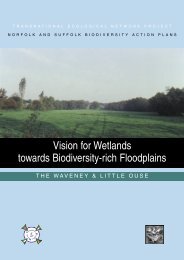
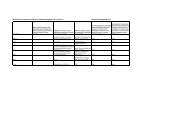
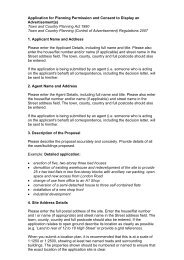
![Brown bin calendar - week 2 [PDF] - South Norfolk Council](https://img.yumpu.com/49352110/1/184x260/brown-bin-calendar-week-2-pdf-south-norfolk-council.jpg?quality=85)
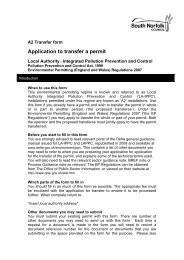

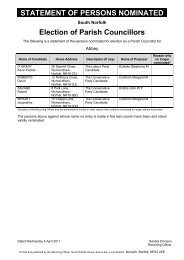
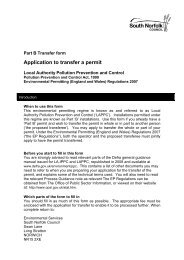
![Link magazine, Spring 2008 [PDF, 4,450k] - South Norfolk Council](https://img.yumpu.com/43994858/1/184x260/link-magazine-spring-2008-pdf-4450k-south-norfolk-council.jpg?quality=85)
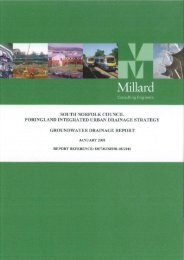
![South Norfolk Council Volunteering Opportunities [PDF]](https://img.yumpu.com/42079564/1/184x260/south-norfolk-council-volunteering-opportunities-pdf.jpg?quality=85)
![Tiffey Valley Guide [PDF, 1,450k] - South Norfolk Council](https://img.yumpu.com/41615145/1/124x260/tiffey-valley-guide-pdf-1450k-south-norfolk-council.jpg?quality=85)
![Queen's Diamond Jubilee Fund [PDF] - South Norfolk Council](https://img.yumpu.com/41088331/1/184x260/queens-diamond-jubilee-fund-pdf-south-norfolk-council.jpg?quality=85)
